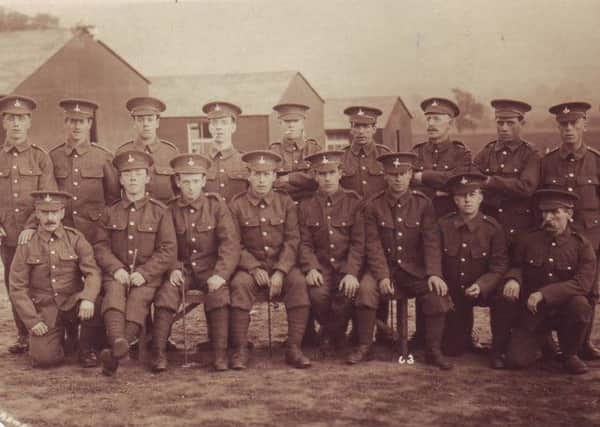Tiny troops who helped bring enemy down to size


WHEN the call went out for men to sign up, volunteers of all shapes and sizes stepped forward.
But despite the urgent need for new recruits not everyone was deemed fit to serve, with thousands of men told they were too small to fight.
Advertisement
Hide AdAdvertisement
Hide AdThis might have been the end of the story had it not been for a handful of hardy Durham miners whose actions led to the creation of what became known as the “bantams.”
John Sheen, author of a book called the Durham Pals, explains. “They tried to sign up in Durham but they were turned down because they were too small, so they walked all the way to Cheshire.”
They were turned down here, too. But Alfred Bigland, a local MP, heard about their plight and wrote a letter to Lord Kitchener offering to raise a bantam battalion. Such was the need for more volunteers that Kitchener agreed and 3,000 men came forward to form two bantam battalions – the first of 24 that served with the British Army during the First World War.
These battalions were made up of men who were between 4ft 10in and 5ft 3in tall and during the course of the war around 50,000 British and Canadian soldiers served as bantams, including Billy Butlin, who later established the Butlin’s holiday camps, and the war poet Issac Rosenberg who was killed in 1918.
Advertisement
Hide AdAdvertisement
Hide AdAt 5ft 5in tall, John King, born into a family of Yorkshire farmers, wasn’t a bantam but he was initially turned away for being too small by Army recruitment officers. Dubbed “the pocket Hercules”, he played rugby union for Headingley and was capped 12 times by England.
Nigel McCrery talks about King in his book, Into Touch: Rugby Internationals Killed in the Great War, describing his determination to join the Yorkshire Hussars. “He walked into the recruitment office and said, ‘I’ve come purposely here to join the same regiment as my friend Lumpy and I’m simply going to stick here until you take me in.’”
His powers of persuasion and, perhaps, his sporting fame worked in his favour and a few days later they relented and he signed up. However, the following year, having not seen any action, his friend, Second Lieutenant Lancelot Slocock – a fellow England rugby player – managed to get him transferred to the Liverpool King’s Regiment.
It proved to be a fateful decision because in August 1916 they were both killed during the Somme Offensive.
Advertisement
Hide AdAdvertisement
Hide AdIn Yorkshire, the bantam battalions quickly proved popular and in Hull around 300 volunteers came forward. The two main ones, though, were the bantam battalion of the West Yorkshire Regiment, the 17th (Service) Battalion, also known as the 2nd Leeds Pals, and the 13th battalion Alexandra The Princess of Wales Own Yorkshire Regiment, which was initially raised in July 1915.
Many of those who joined the West Yorkshire Regiment’s bantams had previously worked as shepherds, miners and also as woollen workers in the mills of Leeds and Bradford.
“In some respects it shows the measure of desperation because after the initial rush of volunteers to the colours there had been a sharp decline, which is why they had to start recruiting undersize men to help plug the gaps,” says Edward Spiers, professor of strategic studies at the University of Leeds.
Nevertheless they proved popular with the public who came out in huge numbers to see these diminutive soldiers parading in the streets.
Advertisement
Hide AdAdvertisement
Hide AdThe bantams serving in the 13th battalion arrived in France in June 1916 and suffered their first casualty that same month when Private W Green died not as the result of a bullet or shellfire, but from bronchitis.
Prof Spiers says that in some cases the men’s size was an issue. “The problem for some of them is they weren’t just small because of genetics, some of them were small because they were undernourished. So while many of these men were very tough and could deal with the stresses of war, there were others who broke down during training and had to be sent to work for the Labour Corps.”
This is one of the reasons why the bantam battalions were often in a state of flux. Also as the war dragged on and the number of casualties rose, new recruits were taken on and what had started out as bantam battalions ended up having a mixture of men and quite often the replacements weren’t of the same pedigree as the original volunteers.
Many of the bantams suffered heavy losses. The 13th battalion was involved in action during the Battle of Cambrai in 1917, one of the first battles where large numbers of tanks were used. They were caught up in ferocious fighting and out of 450 soldiers and 25 officers, just 108 came out of it alive.
Advertisement
Hide AdAdvertisement
Hide AdThe war was an ordeal for all those involved, but particularly for the bantams. In some cases their full kit weighed more than they did and there were reports of several Scottish bantams drowning in the mud after slipping off the duckboards. Some battalions were later disbanded while others, like the Leeds bantams, merged with local regiments.
Nevertheless, the bantams made a big impression on the public. “They were highly respected because they were volunteering to go and fight when a lot of other people weren’t,” says Prof Spiers.
“A lot is made of the fact that something like 2.4 million men did volunteer, but the truth is that far more didn’t. So the fact that the bantams came forward, despite their physical shortcomings, made them hugely popular. They more than did their bit.”